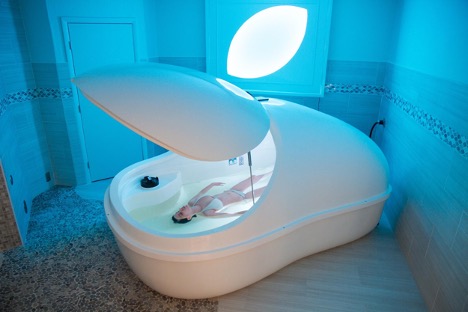Abstract
Purpose
The purpose of this article is to introduce healthcare providers to the concept of floatation therapy. This paper explores which types of patients will most likely find floating beneficial for specific health challenges. In addition, it discusses patients who should avoid floatation therapy.
Method
We conducted a OneSearch of multiple databases using the following search terms: float, floatation therapy, floatation REST, isolation tank, stress, relaxation response, magnesium sulfate, transdermal magnesium, cortisol, pain, depression, anxiety, sleep, and addiction. We used Boolean operators “and” and “or” to narrow the search to 199 articles. We used date of publication, human studies, article type, and relevance to further narrow down this list, resulting in the research that became the basis for this article.
Results
The reviewed studies revealed benefits of floating, specifically regarding participants experiencing muscular pain, depression, anxiety, stress, and sleep disorders. Long-term benefits appear variable.
Conclusion
Floatation therapy appears to be helpful for muscular pain relief and mental health. Many studies conducted thus far are small and outdated; therefore, additional studies on a larger scale are necessary to validate or refute the current data set.
Introduction
Dr John C. Lilly, a neuropsychiatrist who studied how the brain responds to significantly decreased external stimuli, developed floatation therapy in the 1950s to study human consciousness.1 He began studying sensory deprivation at the United States National Institute of Mental Health. Floatation therapy, or “floating,” is also known as floatation “REST,” which stands for Reduced Environmental Stimulation Therapy.
In his investigation into the deeper workings of the mind and consciousness, Lilly sought a way “for an isolated mind to study its own processes, free of feedback with the external world.”2 He did this to challenge the leading hypotheses at that time, which viewed consciousness either as fully dependent upon external stimuli or as automatic, rhythmic processes occurring in the brain and beyond an individual’s control. The sentiment was that without external input, the brain would simply cease working. He stated, “I realized that the key experiment must cut down the various forms of stimulation of the body to the minimum possible value, short of cutting nerve fibers going to the brain.”2 After numerous trials, he developed a set of standards to isolate the body, as much as possible, from all known forms of physical stimulation with the goal of minimizing excitation of the 5 senses.
Lilly’s work took him to floating in water to serve as the best-known vehicle to achieve sensory deprivation. Gleaning from his World War II work in high-altitude research, he devised a breathing apparatus to enable submersion. He eventually forwent the breathing apparatus by using a smaller tank where he could bend his knees while resting his feet on the bottom. This method became cumbersome as he had to breathe in quickly to avoid submersion. His work eventually graduated to seawater (a result of his moving to the Virgin Islands for dolphin research) with ever-increasing concentrations of sodium chloride (NaCl), to a saturation point. While this solved the buoyancy issue, it was quite irritating to the skin, giving rise to the use of Epsom salt.3
In a study looking at 19 athletes and floating, participants not only had improved athletic performance recovery, but also experienced significant improvements in having ‘deeper sleep, fewer awakenings during the night, and a sense of renewed energy upon awakening in the morning.
Individuals lie in a tank, previously called an “isolation tank” and now more commonly referred to as a “float tank” or “float pod.” The pod is filled with approximately 10 inches of water and highly concentrated Epsom salt (MgSO4). Approximately 1,000 to 1,200 pounds of MgSO4 are used to create a specific gravity of approximately 1.25 (more concentrated than the Dead Sea), which allows the individual to float comfortably in a supinated position with the face and ventral surface of the body above water.1 The high-buoyancy water is heated to skin temperature (approximately 34° Celsius) for comfort.4
Traditionally, isolation tanks are enclosed to inhibit light and sound as much as possible and reduce all incoming stimuli. The float experience minimizes sensory signals including visual, auditory, olfactory, thermal, tactile, and gravitational.1 Many modern float pods have options for individual comfort and preference, including a lid that can remain open or shut (or partially open), plus light and music options that the individual can easily control. While light and music options may seem contradictory to the sensory deprivation experience, these can help the individual feel comfortable so they can remove the sensory stimuli when ready. The studies discussed in this article did not use any known light or music options, and all studies were conducted with the combination of water and Epsom salt. The salt-saturated water in most commercial centers is cleaned with a filtration system that runs between each session, in addition to manual skimming and treatment with ultraviolet light, hydrogen peroxide, and ozone. Individuals shower before a float to help keep the water clean, and afterward to rinse off the Epsom salt–saturated water. Generally, a float session lasts for 60 minutes, although it can be shorter or longer.

The floatation therapy industry is rapidly growing, according to Nick Janicki, founder of the largest floatation therapy franchise in the world, during a June 2020 phone interview. Janicki states that in 2010, there were approximately 10 float centers, commonly referred to as float spas, in North America, and that by 2020, there were approximately 500 float centers in North America. Prices for float sessions vary, most falling within the range of $50 to $80 per hour. Most centers promote the benefits of floatation therapy, including pain relief, stress reduction, better sleep, and relaxation.
Magnesium Sulfate
The benefits of magnesium sulfate (MgSO4), better known as Epsom salt, are well known. The World Health Organization (WHO) lists it as an essential medication.5 Examples of use in allopathic medicine (which have specific administration routes and doses) include treatment for hypomagnesemia, pregnancy (eclampsia/preeclampsia), cardiac dysrhythmia (torsades de pointes), constipation, and asthma.6
A proposed mechanism of action of the aforementioned benefits of floatation therapy lies in the transdermal absorption of MgSO4. There are a limited number of studies supporting the transdermal absorption of magnesium. The results are equivocal, largely due to sample size, lack of peer-review scrutiny, and/or methodology.7 Given the selectivity of the stratum corneum layer of the skin and the ionic nature of elemental magnesium, it appears that specific lipophilic carriers are required for MgSO4 to cross the dermal layer into the circulation.8 Chandrasekaran et al observed that hair follicles might provide an alternate entry for magnesium; however, the amount of absorbed magnesium was not specified. Hair follicles represent only 0.1% to 1% of the surface area of the skin,8 leaving this contribution of questionable benefit.
Watkins and Josling observed 9 patients, aged 21 to 69 years, over a 12-week period for the effects of a daily 100-mL magnesium spray on various body areas and a twice-weekly footbath of magnesium oil. Hair analysis, a controversial measurement model, revealed a significant increase in magnesium status of –7.1% to 262%, with an average increase of 59.7%. Serum magnesium levels were not reported in this trial.10
Mimicking or exceeding the magnesium concentration of the Dead Sea (up to 198 mmol/mL) provides a substantial gradient relative to the approximate 0.8 mmol/mL magnesium concentration of the human body.8 In an unpublished report, Nutall et al observed the effects in 19 subjects (10 male, 9 female) of bathing in Epsom salts at concentrations ranging from 400 to 600 mg MgSO4/60 liters (approximately 15 gallons) of water. Participants took baths daily for 7 consecutive days at 50 to 55 degrees Celsius for 12 minutes. The trial resulted in a mean increase in all but 2 subjects of serum magnesium from 104.68 +/- 20.76 ppm/mL at baseline to 140.98 +/- 17.00 ppm/mL at the end of the seventh bath. Urine magnesium showed a mean increase from 94.81 +/- 44.26 ppm/mL at baseline to 198.93 +/- 97.52 ppm/mL 24 hours after the first bath, returning nearly to baseline levels 24 hours after the seventh bath. The authors noted that the individuals who did not experience a significant rise in serum magnesium did show a corresponding increase in urinary excretion, suggesting the possible crossing of dermal layers into circulation and consequent kidney clearance of magnesium resulting from the intervention.11
Pain
It is common for patients to use Epsom salt in a bathtub for the reduction of minor aches and pains, as well as for stress relief. Kjellgren and colleagues found a significant improvement with floatation therapy in those who experienced the most intense muscle pain (P=0.004), but there was no benefit found in participants who experienced lower levels of pain. There were 37 participants in this study, all of whom had chronic muscular pain of the neck and back regions. Individuals floated 9 times during a 3-week period.12
In a Swedish study, 32 individuals with physician-diagnosed muscle tension pain related to stress participated. Specific aspects taken into consideration included number of pain areas and intensity, duration, and frequency of pain.13 All participants took part in 12 float sessions over a period of 7 weeks, and pain was assessed via a pain area inventory. Benefits were seen in patients who experienced both normal levels of pain and severe-intensity pain. Of the 32 participants in this study, 22% became pain-free, 56% had improvement of pain, 19% experienced no increase or decrease of pain, and 3% experienced worsening of pain.13
Sixty-five people participated in a preventive healthcare intervention study, floating 12 times over a 7-week period. Participants with “normal pain” did not experience a statistically significant difference in this study. Patients in the “worst pain” category experienced significant benefit with floatation therapy. Pain was assessed via a visual analog scale, before and after the float session. A descriptive analysis indicated that the “worst pain” decreased from 64.29 (SD=28.13) to 39.70 (SD=32.11) after the treatment period. Research participants emphasized how their pain, including chronic pain, “was practically gone after the 12-session floatation program. They mentioned further how they felt relaxed, slept better, and were overall happier and healthier.”14
Depression and Anxiety
At the Laureate Institute for Brain Research (LIBR) in Tulsa, Oklahoma, researchers have extensively studied floatation therapy, particularly in the areas of depression and generalized anxiety disorder (GAD). One study involving 50 participants at LIBR examined the anxiolytic and antidepressant effects of floating. Results showed a significant reduction in anxiety among participants, regardless of gender. All changes were significant at P<0.0001. Anxiety and stress-related disorders in this study included post-traumatic stress disorder, generalized anxiety disorder, panic disorder, agoraphobia, and social anxiety disorder. In addition to reduced anxiety, there was a significant improvement in mood characterized by “serenity, relaxation, happiness, positive affect, overall well-being, energy levels, and feeling refreshed, content and peaceful.”1 While the results of this study are initially promising, the researchers did not use a control group in this open-label design.
Feinstein et al studied 31 high-anxiety sensitivity and depressed individuals who completed a single 90-minute float session and they found significant improvements in anxiety (P<0.001). Based on the Spielberger State Anxiety Inventory, there was an average reduction of 14 points when comparing the pre- and postsession change in the raw total score.15 Researchers noted a reduction in blood pressure throughout the session as well. The average change in systolic blood pressure from baseline was 5.3 mmHg, and the average change in diastolic blood pressure was 12.8 mmHg. The authors described the participants as experiencing “a robust relaxation response during and after floatation-REST that was decisively anxiolytic in nature.”15
Jonsson and Kjellgren studied floatation therapy in relation to GAD during a 12-week period involving weekly float sessions.16 Of the 46 participants, 37% achieved full remission when evaluated at the end of the 12 sessions, and these anxiolytic effects were maintained at the 6-month follow-up period. Difficulty with sleep, emotional regulation, and depression were also improved, as well as general optimism. The sessions did not reveal an improvement of pathologic worry. Additionally, improvement of depression, a common comorbidity with GAD, during the treatment period was not maintained at the 6-month follow-up.
Stress
Research generally finds floatation therapy to be beneficial for stress reduction. Stress is well known to negatively affect health in a wide variety of ways, contributing to depression, anxiety, obesity, cardiovascular disease, and compromise of the immune system.17 The relaxation response (which is associated with the parasympathetic nervous system) occurs when floating, lowering blood pressure and lowering cortisol levels in some studies.4 In a meta-analysis comparing floating to other stress-reduction techniques, floatation is found to be more effective than relaxation exercises such as progressive muscle relaxation and biofeedback. The pre-post mean effect size with floatation therapy was 1.02 (P<0.001). In comparison, nonfloatation relaxation exercises revealed a mean effect size of 0.35.4
Kjellgren et al explored the effects of floatation therapy coupled with psychotherapy in 6 participants (2 men and 4 women) who were feeling “burned out” at work. Participants in this study had symptoms including fatigue, exhaustion, sleeping difficulty, pain, lack of energy, and feeling overwhelmed. These individuals were on the brink of taking immediate sick leave from work. However, after a 10-week treatment program, all participants were able to continue to work as assessed by both the individual and their physician.18 This was a small study with intriguing results. More extensive studies will be beneficial.
Sleep
People have used floatation therapy to aid with sleep. Since magnesium is a common supplement used to aid with sleep, this is a logical area of float research interest. In a study looking at 19 athletes and floating, participants not only had improved athletic performance recovery, but also experienced significant improvements in having “deeper sleep, fewer awakenings during the night, and a sense of renewed energy upon awakening in the morning.”19
Kjellgren et al observed that floating did not appear to alter the quality or duration of sleep in a study involving 37 patients, but it was found to significantly shorten the length of time needed to fall asleep.12 This may be related to the relaxation and anxiolytic effects of floating. Future studies with magnesium supplementation compared to, or in addition to, floatation therapy will be beneficial.
Jonsson and Kjellgren examined the effects of floatation therapy in relation to anxiety in 46 individuals. There was a strong beneficial effect on sleep difficulties, with 43% of participants reporting sleeping well after a series of 12 treatments compared with 27% of the control group. These benefits were maintained at a 6-month follow-up.16
Comorbidity between anxiety and sleeping difficulty is well established.20 Floatation therapy appears to be a good option for this population to explore, especially given the addictive nature of numerous antianxiety medications.21
Healthcare Provider Role in Advising Patients
Primum non nocere, or “First, do no harm,” as described in the Hippocratic oath, is the duty of a healthcare provider. The clinician’s role is to offer suggestions and solutions while minimizing the risk of adverse effects to the patient. Many psychiatric and sleep medications have particularly concerning side-effect profiles, which can include addiction, drowsiness, impaired coordination, dizziness, and gastrointestinal problems.21 Floatation therapy appears to be a safe, natural option that could potentially reduce medication requirements or potential drug dependence. It may be considered as an alternative or an augmentation to traditional treatment.
As with all treatment suggestions, one must consider not only the benefits, but also the risks involved. There are certain groups of patients who should either avoid floating or consult with a healthcare provider before floating. These are described as follows:
- Individuals who have epilepsy should avoid being in water unsupervised.22 Since floatation therapy is an individual activity, this should be avoided unless close supervision is available.
- Patients with open wounds and/or recent surgery should wait until the wound is healed before floating. Given the extremely high concentration of Epsom salt in the water, this would likely be painful for the patient and potentially unsanitary for the float center. Many float centers suggest that individuals avoid shaving, tanning, and waxing before floating to avoid skin sensitivity, which could interfere with the relaxation of floating.23
- Patients who have kidney disease should consult their nephrologist before floating. The kidneys regulate magnesium balance,24 and therefore, patients with late-stage disease may need to be cautious of exposure to high amounts of magnesium sulfate. Additional research on transdermal absorption will be beneficial for this patient population.
- Since deep relaxation can lower blood pressure,4 it is advisable for patients who have orthostatic hypotension to take their time standing up upon the completion of a float. Orthostatic patients should move slowly from a supine to sitting position, pause until comfortable, and then slowly transition from sitting to standing. Patients should hydrate on the day of the float (and in general), and they should shower at a neutral temperature (not hot) after the float to rinse off the Epsom salt water.
All treatment options, both pharmacologic and nonpharmacologic, should involve close follow-up to monitor the patient’s progress.
Future Research
Interest in this passive and relaxing form of therapy is rising, and it has caught the attention of the National Institutes of Health (NIH). The LIBR has been awarded a 3-year, $727,000 grant from the NIH to examine the safety, feasibility, and tolerability of floatation-REST in patients with anxiety and depression.25
Conclusion
Floatation therapy is a rapidly growing trend. Individuals lie supine in a float pod filled with 10 inches of water and highly concentrated magnesium sulfate (MgSO4). Studies indicate promising results from floatation therapy for pain reduction, depression, anxiety, stress, and sleep.26 Many studies thus far are small and/or outdated, so additional research will be fruitful.
Floatation therapy appears to be beneficial for many individuals without the side-effect profile of traditional medication treatment. Providers may consider floatation therapy to augment traditional treatment and/or for treatment-resistant patients. However, this modality is not advised for certain populations, specifically those with seizures, open wounds, and kidney disease. Close follow-up for therapeutic interventions and treatment augmentation is always advised.
Acknowledgements
We are deeply grateful for the encouragement and support of the dean, faculty, and staff in the Doctor of Medical Science Program at the University of Lynchburg.










